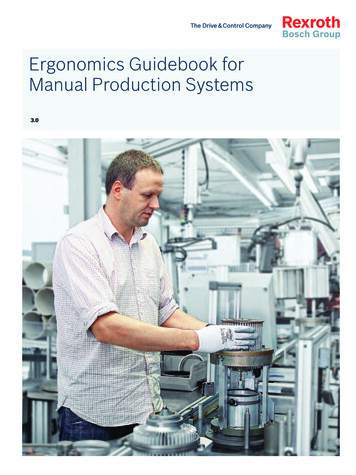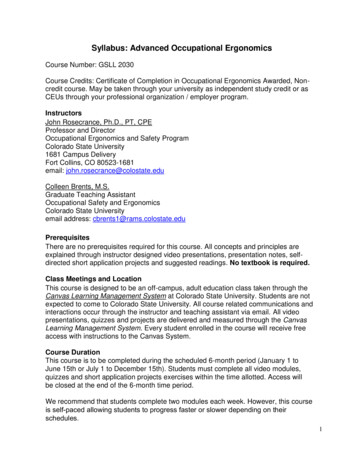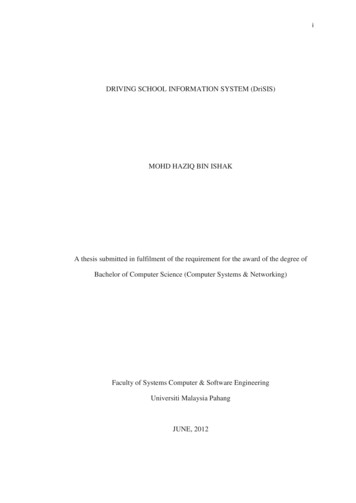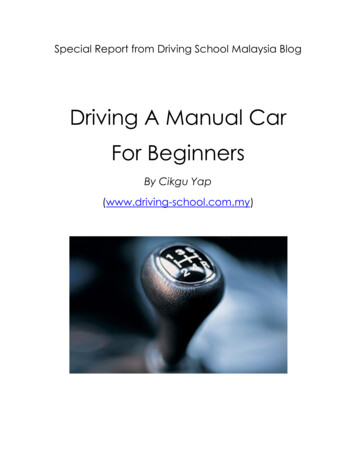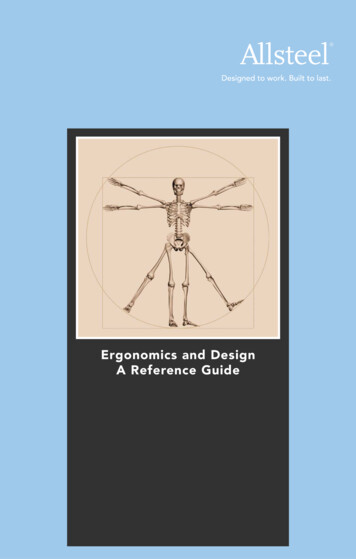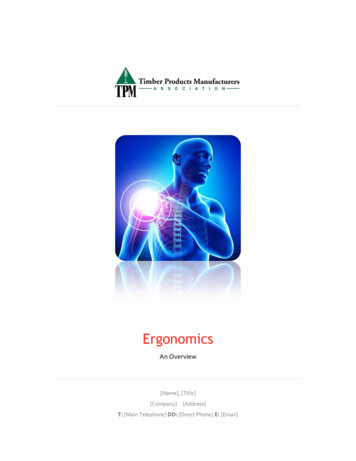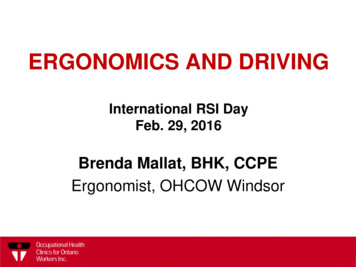
Transcription
ERGONOMICS AND DRIVINGInternational RSI DayFeb. 29, 2016Brenda Mallat, BHK, CCPEErgonomist, OHCOW Windsor
Overview Physical hazardsSelecting a VehicleSteps to Injury PreventionWorking from your vehicleHuman factors / cognitive hazards
Driving Statistics On average men drive 71kms, women drive 55kmseach day Studies have foundsignificant associationsbetween driving andback problems. One study analysis forthe possible reasonsrelated to reporting of lowback pain found:– Long-term vibrationexposure from drivingamong the HIGHEST riskfactor for neck, back andlow back problems.
Problems with Frequent Driving Neck, back and shoulder pain Cramps, pressure points & poor circulationin the legs & buttocks Immediately after driving – increasedchance of low back injury from lifting Long-term potential for degeneration ofspinal discs and disc herniation
What Activities Increase Risk?ACTIVITYRISKDriving 30 km or more Two to four times risk of backa daypainTruck DrivingFour times risk of discrupturesCar DrivingTwo times risk of disc rupturesIncreased VibrationDriving a busIncreased tension, fatigue,painBack pain risk increasedOHS Canada, Oct., 2000
Who is at Risk? Truck drivers / Ambulance DriversHeavy equipment operatorsBus driversForklift operatorsFarmersDelivery and courier service workersTaxi / Limousine DriversTravelling sales workers
Back & Neck Injuries Two main hazards– Sitting for long periods of time– Whole-body vibration
SITTING Hazards An AKWARD postureA STATIC postureA WORKING positionHard on DISCS & LIGAMENTS of theback Restricts BLOOD CIRCULATION throughthe muscles fatigue
Posture and Lumbar Load
Long Term Sitting Sitting is a static posture– BUT not void of musclecontraction BUT, only some musclesNOT all – therefore, somemuscles work constantly,while others do nothing!!
Backrests (Lumbar Supports) Sitting flattens lumbar curve– Changes biomechanics ofspine– Increased forces on discs– Increased length of ligaments– Increased muscle tension Need support for curvature
Whole-Body Vibration Transmitted through the back & buttocks when sitting Every object has a ‘resonant frequency’ (RF) 3-5 Hz –vibration from the road is often in the body’s RF range;this increases the risk of injury Long-Term exposure:––––––Disc displacementDegenerative spinal changesLumbar scoliosisIntervertebral disc diseaseHerniated discsDisorders of gastrointestinal system
Reducing Effects of Vibration Reduce transmission– Improve vehicle suspension– Maintain equipment properly– Proper engineering of seating– Use of materials that generate LESS vibration Decrease amount– Reduce speed of travel– Increase rest/recovery time between exposure– Alternate tasks to minimize vibration exposure
Reduce – cont . Modify the seat and control positions– Back rest support– Reduce forward/sideways leaning of trunk Eliminate awkward postures– Difficulty seeing displays or reaching Reduce or isolate from the vibrationsource– Seated – spring or cushion (as an isolator)
Lifting after Prolonged Sitting
Manual Handling Tips Adopt good postures when MMH Get as close to the item as possible – thereforeorganize the trunk accordingly Try to park as close as possible to drop off point. Take care when MMH after a long drive – walkbefore handling Use wheeled bags Consider making 2-3 trips instead of one
Manual Handling
Selecting a Vehicle(CCOHS) Does it match requirements for the body size of thedriver(s) & any physical limitations Do the layout & ergonomic features of the vehicle meetyour needs? How much time per day does the driver use the vehicleand what distance do they drive per year? Does it have features that assist in the kind of work thedriver does – eg. Easy to load trunk (salesperson)
Ideal Car/Cab Design Adjustable seat back incline (100o)Changeable seat bottom depthAdjustable seat heightAdjustable seat bottom inclineSeat cushion with firm (dense) foamAdjustable lumbar support (V & H)Adjustable bilateral arm restsAdjustable head restraint
Car Seat Design – cont Seat shock adsorbers to dampenfrequencies between 1 – 20 hz. Linear front-back seat travel to allowdifferently sized drivers to reach thepedals Seat back damped to reduce reboundingof the torso in rear-end impacts
Car features: Seat Base Adequate leg length– Ensure thighs are adequately supported Picture A – too short Picture B – too longA Adequate height adjustment Feet can operate pedals withoutstretching All controls are easily reached All display instruments can beseen Good all round visionB
Car features: Back Rest Ensure the height of the back rest reaches the shouldersand does not obstruct ‘rearward vision’ Ensure the back rest width is enough tosupport the shoulders
Car features: Steering Wheel Adjustable steering wheel – in/out, up/down andtilt Power steering Centrally positioned and not ‘off-set’ to preventrotation of the spine Ensure steering wheel does not obstruct thedisplay panel
Steps to Injury Prevention Learn how to get in and out of vehicle Use a good sitting posture – use lumbar support Tilt the backrest to 110 degrees from you legs to reducedisc pressure If possible, tilt the seat a notch or two back and forthevery 20-30 minutes – alters the direction of vibration Adjust the steering wheel – ensure you can press thepedals without moving your low back off the back of seat Avoid slouching If possible, change positions while driving
Steps to Injury Prevention Adjust your headrestAdjust your armrestsCheck your hand position on the steering wheelTry to take regular rest/stretch breaks. Only 5 minuteswill suffice Avoid lifting immediately after driving – give yourself onor two minutes to stretch and rest before lifting
Working from your vehicle Working from a vehicle can entail use of alaptop, general paperwork, mobile use ormanual handling. This could involve:– Static and awkward postures– Twisting and leaning to one side– Leaning forward– Slouching
Best location for a computer A & B – poor bodypostures &increased musclestrain– Increased musclefatigue– Increased risk oflow back pain– Increased risk ofshoulder MSDs
Devices for laptop use
Human Factors & Driving Speeding Fatigue Distracted Driving
Speeding Safety features can be breached oncedrivers pass certain speed thresholds– Antilock braking systems (ABS)– Brake assist– Electronic brake-force distribution (EBFD)– Electronic stability control (ESC)
Fatigue Fatigue can be experienced for a variety ofreasons:– Inadequate sleep– Alcohol / medications– Prolonged hours driving– Time of day
How does Fatigue affectSafety At risk for ‘nodding off’ at the wheelSlower reaction timesReduced overall attentionSlower decision-makingDelayed information processingFatigued drivers not very good at gauging theirown fatigue level Car safety features become ineffective(similar to speeding)
Distracted Driving Transport Canada– Fatal collisions where distraction is cited ascause have risen by 17% in Canada from 302deaths to 352 from years 2006-2010– Studies estimate that distracted drivingaccounts for 30-80% of collisions – cellphoneuse
Distracted Driving (CAA) Cell phones are the most common distraction Texting – 23 times more likey to be involved in acrash or near crash event compared with nondistracted drivers 84% of distracting-driving-related fatalities in USwere tied to the general classification of carelessor inattentiveness 80% of collisions and 65% of near crashed havesome form of driver inattention as contributingfactors
Distracted Driving (CAA) Distracted drivers are 3 times more likey tobe in a crash than attentive drivers Driver distraction is a factor in about 4million MVA in North America Children are 4X more distracting thanadults as passengers – infants are 8X
Cell Phone Use Bluetooth Hands-free car kit
Brain on Board:Your brain is your vehicle’s mostimportant safety featurehttp://brainonboard.ca/myths andmisconceptions/
Safety Tips!! /Videos.asp?ReportID 37200
Thank YouIf you have any questions about this presentation,please contact me at the email/number belowOHCOW Windsor ClinicBmallat@ohcow.on.ca3129 Marentette Ave Unit 1Windsor N8X 4G1(519) 973-4800 ext. 2507www.ohcow.on.ca
Driving Statistics On average men drive 71 kms, women drive 55 kmseach day Studies have found . significant. associations . between driving and back problems. One study analysis for the possible reasons related to reporting of low back pain found: - Long-term vibration exposure. from driving among the HIGHEST risk factor for neck .

